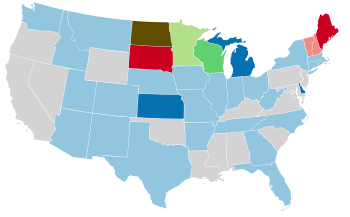| ← 1934 1935 1936 1937 1938 → Presidential election year | |
| Election day | November 3 |
|---|---|
| Incumbent president | Franklin D. Roosevelt (Democratic) |
| Next Congress | 75th |
| Presidential election | |
| Partisan control | Democratic hold |
| Popular vote margin | Democratic +24.3% |
| Electoral vote | |
| Franklin D. Roosevelt (D) | 523 |
| Alf Landon (R) | 8 |
 | |
| 1936 presidential election results. Red denotes states won by Landon, blue denotes states won by Roosevelt. Numbers indicate the electoral votes won by each candidate. | |
| Senate elections | |
| Overall control | Democratic hold |
| Seats contested | 36 of 96 seats (32 Class 2 seats + 6 special elections) |
| Net seat change | Democratic +6 |
 | |
| 1936 Senate results
Democratic gain Democratic hold | |
| House elections | |
| Overall control | Democratic hold |
| Seats contested | All 435 voting members |
| Net seat change | Democratic +12 |
 | |
| 1936 House of Representatives results
Democratic gain Democratic hold | |
| Gubernatorial elections | |
| Seats contested | 36 |
| Net seat change | Democratic +1 |
 | |
| 1936 gubernatorial election results
Democratic gain Democratic hold | |
The 1936 United States elections were held on November 3, 1936, during the Great Depression. Democratic President Franklin D. Roosevelt trounced Governor Alf Landon of Kansas in a landslide and the Democrats built on their majorities in both chambers of Congress.
In the presidential election, incumbent Democratic president Franklin D. Roosevelt won re-election, defeating Republican governor Alf Landon of Kansas. Roosevelt took every state but Vermont and Maine, winning with the fourth-largest electoral vote margin in American history. Roosevelt took just under 61 percent of the popular vote, a number that only Lyndon Johnson would surpass (although the popular vote was not officially counted prior to the 1824 election). Landon decisively won his party's nomination over Idaho Senator William Borah.
The Democrats gained twelve seats in the House of Representatives, furthering their supermajority over the Republicans. The Democrats also maintained a supermajority in the Senate, gaining seven seats. These elections marked the last time in U.S. history in which any party held three-fourths of all seats in both chambers of Congress.
See also
- 1936 United States presidential election
- 1936 United States House of Representatives elections
- 1936 United States Senate elections
- 1936 United States gubernatorial elections
References
- Two Class 2 seats held both a regularly-scheduled election and a special election in 1936. These two seats are not double-counted for the total number of seats contested.
- Democrats picked up five seats in the regularly-scheduled elections and picked up an additional seat in the special elections.
- "1936 Presidential Election". The American Presidency Project. Retrieved December 28, 2011.
- ^ "Statistics of the Presidential and Congressional Election of November 3, 1936" (PDF). U.S. House of Reps, Office of the Clerk. Retrieved December 28, 2011.
- Statistics of the Presidential and Congressional Election of November 3, 1936 (Revision). U.S. House of Reps, Office of the Clerk. 1936. Retrieved March 1, 2021.
This American elections-related article is a stub. You can help Misplaced Pages by expanding it. |